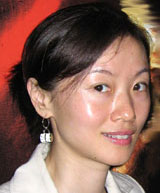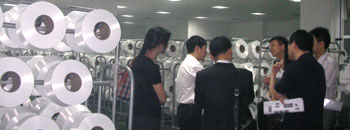
Financial PR's MD Kathy Zhang led 11 investors on investigative trip to China's textile sector.
Nevertheless, 11 investors, including QDII funds and high net-worth Singapore investors, embarked on a trip recently to investigate the textile value chain in hopes of identifying winners.
Companies they visited included makers of Xtep sportswear, Erke tennis shoes and Dapai haversacks, as well as their supporting synthetic fiber and fabric makers, FibreChem Technologies, Li Heng and China Taisan.
Financial PR’s managing director Kathy Zhang led the group to the textile hub in Fujian to visit the factories of domestic brands behind the fashion landscape of China’s generation Y.

Textile value chain of companies visited
Which companies will win over Gen-Yers as they move up the ladder of economic prowess?
Will it be imported brands? Or will domestic brand owners who started out as sub-contract suppliers be able to close the brand status gap?
The likely winners will be those with the technology edge, margins and economies of scale to buffer the rising costs of operation, according to insiders.
Riding out the industry consolidation
A quick comparison of the textile players visited suggests the leading synthetic fiber makers have a more lucrative business than some brand owners.
Li Heng, a leading producer of high-end nylon in China with a 15% market share, has one of the highest operating margins (34%).
SGX-listed |
Price S$ | Mkt Cap S$mln |
Sales S$mln |
Historic PE | Operating Margin % |
| FIBRECHEM TECH | $0.590 | 532.9 | 313.5 | 5.5 | 34.8 |
| LI HENG CHEMICAL | $0.575 | 977.5 | 544.5 | 4.4 | 33.5 |
| CHINA TAISAN | $0.180 | 167.0 | 160.1 | 3.5 | 31.1 |
| CHINA ZAINO INTL | $0.415 | 392.2 | 299.8 | 6.5 | 25.3 |
| CHINA HONGXING | $0.475 | 1,206.5 | 404.0 | 11.8 | 23.0 |
HK-listed |
|||||
| XTEP INTL | $0.501 | 1,101.7 | 269.5 | 16.8 | 19.5 |
Pushing for export quality

Chinese online mart www.smarter.com retails imported swimwear for Rmb 450 to Rmb 1,200.
Last year, China overtook the USA to become the world’s largest nylon producer with a market share of 24.8%. It grew its output 15% despite a decline of 1.7% in global nylon output to 3.8 million tons.
China is still a net nylon importer, relying on imports for high-grade nylon. It imported 223,300 tons of nylon fibre in 2007.
The nylon produced by Li Heng is of a quality that borders on domestic and import grade, such as that which is required for high-end delicate and fine lingerie and undergarments, premium sportswear, including swimwear.
Imported brands of swimwear and lingerie don’t come cheap: a swimsuit can retail for as much as what a PRC production worker earns in a month.
By producing high-end nylon, Li Heng has maintained gross margins at about 35%.
 Investors from QDII funds Changcheng and Zhongyin, as well as other funds such as BOC, China Merchants, Cheetah, Fullerton, JK Capital, Marathon and Martin Curie in Q&A with the chairman at a finished nylon yarn storage room.After Kathy compared Li Heng's nylon quality with what she saw at a competing nylon factory, she concludes that customers were willing to pay Li Heng's asking price for the difference it made to the apparel produced.
Investors from QDII funds Changcheng and Zhongyin, as well as other funds such as BOC, China Merchants, Cheetah, Fullerton, JK Capital, Marathon and Martin Curie in Q&A with the chairman at a finished nylon yarn storage room.After Kathy compared Li Heng's nylon quality with what she saw at a competing nylon factory, she concludes that customers were willing to pay Li Heng's asking price for the difference it made to the apparel produced.Polyamide, a by-product of oil, comprises over 90% of Li Heng’s cost of sales.
The company has been able to pass on rises in the cost of raw materials to customers but is addressing the issue of rising oil prices by building facilities to produce polyamide chips by 3Q09.
To meet demand for high-end nylon, the company is ramping up capacity 3-fold: 257,200 tons by 3Q09, up from 92,400 tons in FY07.

Plant under construction will produce polyamide by 3Q09. Photo by Kathy Zhang.
”Huge though the capacity increase may seem, it is wholly driven by orders,” said Mr Chen.
Order management is important, as nylon has a shelf life of only 5 months, during which it has to be stored at the right temperature and humidity. After 5 months, it is downgraded and selling prices are adversely affected.
To maximize utilization, the company has a policy of serving a wide customer base and accepts not more than 60% of orders placed by each customer.
The strategy appears to be working: utilization has exceeded 90% in the past 2 years.
Kathy noted that Li Heng’s plant is very well managed. It operated 24/7 without a need for maintenance downtime.
Stock rebounds from historic low
 The delegates flew back to Singapore on 5 Jul, which is coincidentially the day after Li Heng closed at a historical low of 49.5 cents.
The delegates flew back to Singapore on 5 Jul, which is coincidentially the day after Li Heng closed at a historical low of 49.5 cents.What a buying opportunity it was for them: the stock rebounded sharply by over 20% in the following week to close at 62 cents.
Separately, Deutsche Bank, which was not on the trip, reiterated its buy call on Li Heng with a target price of S$1.40, while UOB Kayhian initiated coverage with a buy call with a target price of 84.5 cents.
Deutsche Bank analyst James Tan believes that the stock is undervalued due to concerns of lower global demand for textiles amid rising oil prices and inflationary cost pressures.
To address cost pressures, Li Heng is looking to produce its own polyamide by 3Q09.
Meanwhile, textile players are looking forward to an increase in rebates on exported clothing from 11% to 15%, which is widely touted to materialise in the near future.







